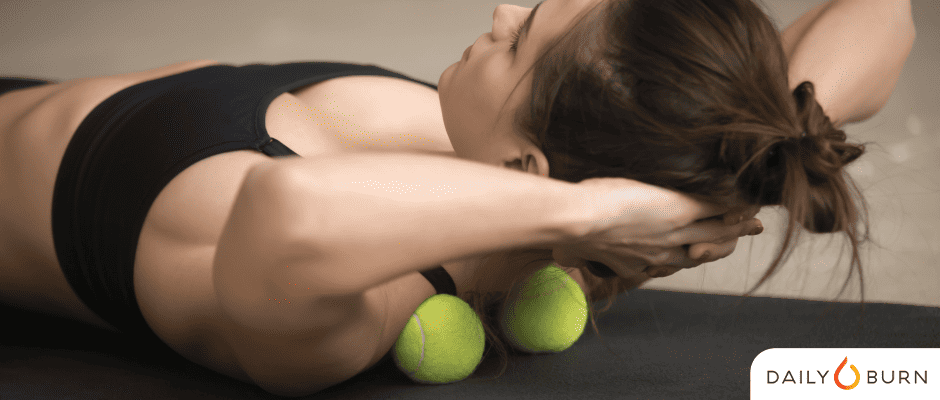The pandemic has drastically changed so many things in our day-to-day routines, and for many of us, we’ve shifted to working from home indefinitely. While there are perks to having an “office” just a few steps from your bed (hello midday laundry!), it’s undeniable that without a commute and office, we’re moving around less and spending more time in an undesirable position.
In an office setting, you are constantly moving and getting exercise, even if you don’t realize it. You have to walk to the bathroom, to the copier, to and from the parking lot or public transportation, to your co-worker’s desk to chat, and more. At home, it’s easy to spend hours sitting in front of your computer, only getting up to walk a few steps to the kitchen for another cup of coffee. Before you know it, the workday has passed, you’ve been sitting all day, and your shoulders and neck are tense from typing and staring at a screen.
Dane Robinson, Daily Burn trainer and fitness pro, says that it’s very common to have chest tightness that can lead to soreness elsewhere. “From a basic lifestyle perspective, we do a lot of anterior movement, which is movement on the front side of the body, like pushing, typing, or moving things in front of us,” he says. “All of this works and puts tension on the chest in just our everyday movements. Then, we exercise and work our chest even more. All of this targeted movement can cause tightness and overuse, which will eventually lead to soreness, and even injury.”

If your day ends and your shoulders and upper back are screaming from sitting, a few simple stretches and movements can make a world of difference. It’s not enough to do some shoulder openers and call it a day, though. You have to address the opposite muscle group: your chest, or pecs.
Why Do Your Chest Muscles Cause Shoulder Tightness?
Your chest muscles, both the large pectoralis major and smaller pectoralis minor, are attached to your upper body and shoulder blades. If they’re tight, they pull your shoulders forward and create tension and soreness in your upper back. The tightness in your chest, though, can start when your upper back is stiff due to poor posture. Each muscle group can negatively affect the other when your posture is out of alignment and the muscles are strained and tense. The tighter your chest, the more your shoulders are pulled forward. The tighter your upper back, the stiffer your chest.
Robinson says it’s common to feel soreness where the pec and shoulder muscles meet, so how do you break this vicious cycle? By focusing on and adjusting your posture throughout the day, and stretching and mobilizing both your chest and upper back.
Quick Posture Fixes
Your neck, shoulders, and upper back need to be in alignment to maintain correct posture, and focusing on this will reduce tightness in your chest. Make sure your workspace is set up for posture success and focus on how you sit, with your feet planted firmly on the floor and your monitor at eye level. No budget for new equipment? Not to worry. You can simply stack your laptop on books until it’s at the correct height, and try different chairs in your home until you find the right fit.

Try to remember to lift your phone to eye level whenever you’re looking at it, and use it as a tool to support better posture habits when you sit! Set an alarm to go off every hour. When it does, reassess your posture and make any needed shifts. Engage your core, try some shoulder pinches and chin tucks, and take a few deep breaths to reset.
The Best Stretch to Release Chest Tension
Targeted chest release is a quick way to open up a slouched or sore upper body, whether it’s from improper posture or tough exercise. A “doorway chest stretch,” according to Robinson, is the easiest way to stretch this part of the body.

“Place your arms in a field goal position while standing in a doorway,” Robinson says. “With your forearms on the door frame, lean your body forward and breathe into the stretch. Hold for about 10-15 seconds and repeat three times.”
If you can contract the tight areas while doing the stretch, even better. Tensing and releasing can increase circulation and send more oxygen to the muscles, providing a deeper stretch while helping your body and mind relax at the same time.
Mobilize Your Upper Back
Remember, tightness in your chest and upper back go hand in hand, so it’s not enough to just stretch your chest and call it a day. Mobilizing (moving) your upper back will help the joints and muscles de-stiffen, and you’ll feel almost instant relief.

Fascia is the connective tissue surrounding your muscles and you can loosen it by using a lacrosse or tennis ball. Simply lie on your back or lean against a wall, place the ball in between your spine and shoulder blade, and roll around on it until you find a spot that feels tight or tender. When you find the spot, stop moving and take deep breaths in that position. Try to stay there until you feel the body give beneath the pressure and release. It’s tempting to just roll around on the ball, and that does have some benefits, but it’s better to find the sore spots and stay still with constant, specific pressure. Don’t place the ball on bone, like your spine or shoulder blade, and be warned that it can be an intense sensation. Take deep breaths throughout the exercise and stop if you’re feeling actual pain.
While sitting and working at a desk might be unavoidable, chest tightness and shoulder pain is not. If you have to sit, try these three things for immediate relief!
Not a Daily Burn member? Sign up at dailyburn.com and start your free 30-day trial today.
Cover image by Daily Burn. Feature images via Shutterstock
